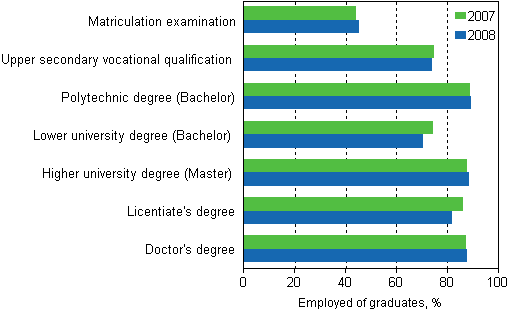Published: 23 March 2010
Transition to working life almost as smooth for recent graduates in 2008 as one year before
Transition to working life was almost as smooth for recent graduates in 2008 as one year before. Transition to work was smoothest for those with tertiary degrees. Just short of 90 per cent of them were employed at the end of 2008. The proportions of those with polytechnic degrees and masters with higher university degrees finding employment rose slightly. In all, 74 per cent of those with upper secondary vocational qualifications were employed, the proportion being half a percentage point lower than the year before.
Employment of graduates one year after graduation by level of education 2007 and 2008, %

Although the proportion of the employed remained almost unchanged, that of the unemployed grew and the proportion of those continuing studies decreased from the year before. The proportion of the unemployed grew from six to seven per cent. Graduates with upper secondary vocational qualifications had the highest proportion of unemployment, 11 per cent, i.e. two percentage points more than one year before. Five per cent of the graduates from polytechnics and four per cent of the graduates with higher university degrees were unemployed. The proportions of unemployed graduates with university degrees were of the same magnitude as the year before. Those having taken matriculations examinations and lower university degrees were most continuing their studies. Thirty-eight per cent of the passers of the matriculation examination in the previous year continued studying full-time and 28 per cent of them studied while working.
There are some differences in men’s and women’s transition to work. Of men, 65 per cent were employed and of women 76 per cent. Eight per cent of men and five per cent of women were unemployed.
There were differences in the transition to working life by field of education. The rate on employment varied from 98 per cent in the field of safety and security to 70 per cent in the field of culture. The transition was smoothest for completers of a qualification in the fields of safety and security, welfare, health and sport, social sciences, business economics and administration, and humanities and education. In all fields of education the transition was easier for those with university degrees than for those with upper secondary qualifications. The number of the unemployed was highest for those with upper secondary qualifications in the field of natural sciences, 16 per cent.
Examined by region, the rate of employment varied from 85 per cent in Åland to 61 per cent in North Karelia. Besides Åland, the rate of employment was higher than the average for the whole country in the regions of Uusimaa, Itä-Uusimaa, Ostrobothnia and Kanta-Häme.
Source: Education 2010. Statistics Finland
Inquiries: Ritva Kaukonen (09) 1734 3311, koulutustilastot@stat.fi
Director in charge: Jari Tarkoma
Publication in pdf-format (213.1 kB)
- Tables
-
Tables in databases
Pick the data you need into tables, view the data as graphs, or download the data for your use.
Appendix tables
Updated 23.03.2010
Official Statistics of Finland (OSF):
Transition from school to further education and work [e-publication].
ISSN=1798-9469. 2008. Helsinki: Statistics Finland [referred: 25.12.2025].
Access method: http://stat.fi/til/sijk/2008/sijk_2008_2010-03-23_tie_001_en.html

